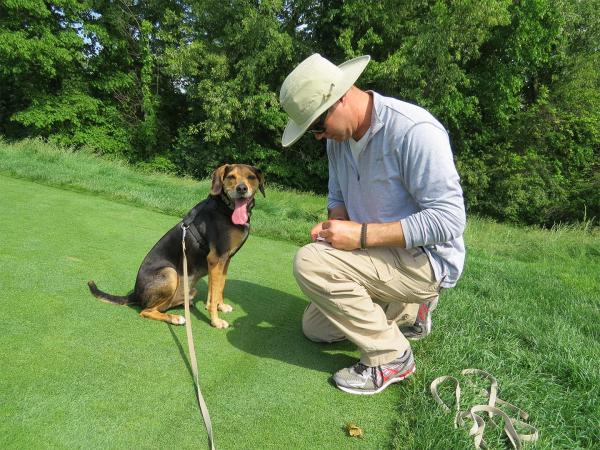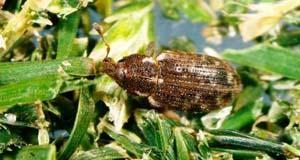For a pest that is so small, annual bluegrass weevil has proven to be a mysterious and adaptive critter that has made understanding and controlling it a challenge for superintendents and researchers alike.
 "My lab does a lot of basic biology to understand their behavior," said Penn State entomologist Ben McGraw, Ph.D. "You would think we would have it all solved by now, but they are spreading outward and encountering different plants. They move and they behave differently. We are starting to see that in some of our studies in places like Maryland and Virginia."
"My lab does a lot of basic biology to understand their behavior," said Penn State entomologist Ben McGraw, Ph.D. "You would think we would have it all solved by now, but they are spreading outward and encountering different plants. They move and they behave differently. We are starting to see that in some of our studies in places like Maryland and Virginia."First identified as a pest in managed turfgrass in 1931 in Connecticut, annual bluegrass weevil (Listronotus maculicollis) historically spend the winter off the turf, but emerge in spring to lay eggs between the sheath and stem in annual bluegrass plants, typically about the time forsythia are in full bloom.
According to McGraw, the newly hatched larva molt multiple times inside the plant before emerging during the third instar phase to feed. Eventually, the pest enters the pupa stage, drops into the soil and emerges as an adult in a six-to-eight-week process that can repeat itself two or three times per summer, depending on the geographic location. Damage can occur from tee to green, but over time has been most prevalent in collars. Researchers and superintendents are quickly learning that nothing is absolute.
For the first 60-plus years after it was found in Connecticut, ABW's sphere of influence had been largely confined to metropolitan New York.
So little was known about ABW 30-40 years ago, that many superintendents misdiagnosed the damage as something else. Pat Vittum, Ph.D., entomologist at the University of Massachusetts, was just completing work toward her doctorate degree when she spoke on ABW at the old Massachusetts turf conference. Show officials then told her that none of the courses in that area had an ABW problem. That was in 1981.
"When I got back to my office, my phone was ringing off the hook with superintendents saying 'I had no idea about annual bluegrass weevil, but here it is,' " Vittum said. "It's not like I brought starter-kits and dumped out weevils. It was a matter of increased awareness."
ABW is not a prolific flyer, in fact Vittum says the ones in her lab might fly more than those outdoors as they make a break for an open window. Still, during the past three decades damage has been recorded as far west as the Cleveland area and as far south as the mountains of North Carolina.
So, is ABW a critter on the move, or is it a native pest adapting to its environment?
"That's a good question," Vittum says.
Although ABW is a problem for superintendents in only a handful of locations, the species has been identified in about 35 states, according to Vittum, leading her to conclude that it is a pest adapting to a changing environment.
"As turf-management strategies change, the damage we see from the insect changes," she said. "As we lower heights of cut, that is an additional stress to the turf, add in a pest that has been there a long time and we see more damage in places we didn't used to see damage. I think that is part of what is going on."
McGraw has been working with Scentworx, a Florida-based company that trains rescue dogs to sniff out all sorts of problems, like bed bugs for the hotel industry, and annual bluegrass weevils for McGraw. McGraw and Jason Webeck of Scentworx brought Carl, the weevil-sniffing dog, to Oakmont a few weeks before the U.S. Open to see whether the course had any weevil issues. Carl has been trained to sniff out all stages of weevil, from egg to adult. McGraw would like to see other dogs trained for that purpose to ensure greater accuracy, but that is expensive and requires outside funding.
McGraw says it might be easier to learn more about weevils by knowing the history of the golf courses they harass rather than the pests themselves.
"A lot of the wounds we see are self-inflicted. What makes one course susceptible and one not is history: How long have you been applying insecticides and what insecticides?" McGraw said.
"From 1957 to the 1980s, it was around New York and New Jersey. In the 1980s, its range really ramped up, and then again in the '90s.
"It is when mowing heights dropped that it became a problem. By mowing fairways with greens units we've been making more of an ideal host plant. Only when damage is present is its presence obvious to superintendents. So, have we been making more of an ideal host plant and it was it always there and we never knew it?"
Understanding the enemy here is not easy, because not all weevils are created equally.
 ABW in the warmer extremes of its current range, places like southern New Jersey, Delaware, Maryland and Virginia, have developed a taste for creeping bentgrass, while those in the North Carolina mountains, where the climate is cooler, still behave like those in New England, where they stick to a strict diet of annual bluegrass. Some superintendents have used ABW for biological control of Poa annua on primarily bentgrass surfaces. Vittum says that is not an acceptable practice for everyone, including those in the southern extremes of ABW territory where weevils view bentgrass as a perfectly suitable food source.
ABW in the warmer extremes of its current range, places like southern New Jersey, Delaware, Maryland and Virginia, have developed a taste for creeping bentgrass, while those in the North Carolina mountains, where the climate is cooler, still behave like those in New England, where they stick to a strict diet of annual bluegrass. Some superintendents have used ABW for biological control of Poa annua on primarily bentgrass surfaces. Vittum says that is not an acceptable practice for everyone, including those in the southern extremes of ABW territory where weevils view bentgrass as a perfectly suitable food source."In the Delmarva area, don't use weevils for Poa control, or you're going to be looking for a job," she said. "If you don't know how much Poa you really have, you're going to be looking for a job."
In the past, superintendents could get reasonable control by ringing in-play areas with pesticides. It wasn't until second or even third generations were active that visible damage might move to other parts of the golf course, but no more.
This year, Vittum has seen extensive damage from first-generation ABW well into golf course fairways, leading her to conclude that adults probably overwintered there.
"Normally, damage from the first generation is noticeable on the edges of fairways, tees and collars. We don't normally see damage in the fairway from the first generation," she said.
"They don't always behave the same way from one year to another. Clearly, it behaves differently in the southern end of its range in places like Virginia, Maryland, Delaware and New Jersey, and we don't know why it differs. It appears to be the same insect, but we haven't yet looked at its DNA. Are we looking at two different species, or biotypes?
"You might have 30 larvae in a square foot and half of them are females getting ready to produce as many as 100 eggs. With as many as four generations per year, there is a lot of opportunity for genetic diversity."
One thing is certain, it is quite able to adapt to its immediate environment,
Even what pesticides to apply and when are not easy questions to answer.
ABW populations in New England first showed resistance to pyrethroids a decade ago, and have since exhibited resistance to non-pyrethroid chemistries as well.
"You could have all shades of gray," McGraw said. "You could have intense resistance, moderate resistance. Resistance is all over the place. In some places, it has become highly resistant after five years.
"A new person comes in and inherits the sins of the father, and that probably happens more than we know. A superintendent is trying to save his job and will try to create blemish-free conditions. Once you develop high resistance, extreme measure have to be taken."
Timing of pesticides is critical as ABW is vulnerable both in the larval and adult stages. Adulticides, however, have shorter residual activity than larvicides, but as life cycles vary, generations begin to overlap and it becomes difficult to know exactly which generations are present.
"Some of the early ones become adults more quickly and they get about the business of laying eggs very quickly. The ones that come along more slowly lay eggs later," Vittum said. "By the time you get to July, you truly can find every stage in a single sample. Is this second generation, or early third or late first? It's a challenge to find out when a new influx of adults is ready to reproduce. We know how long it takes each stage to develop at different times of the year, so you do your best to make an educated guess.
"It has developed resistance quickly and adapts to new conditions much faster than a lot of things we see. Why? I don't know, but it appears be quite resilient."

